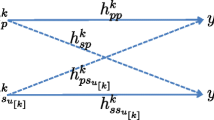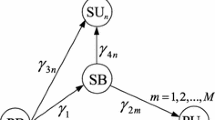Abstract
For the underlay spectrum sharing, a primary transmitter (PT) and a secondary transmitter (ST) can transmit simultaneously to a primary receiver (PR) and a secondary receiver (SR), respectively. The transmit power of ST is strictly controlled under the performance constraint of primary system. The strong interference from PT and the weak signal from ST make the communication quality of secondary system very poor, especially when the two systems are close. In this work, we adopt the successive interference cancellation (SIC) technique at either or both of PR and SR for the data detection. Four spectrum sharing schemes are studied, i.e., PR–DIR–SR–DIR, PR–DIR–SR–SIC, PR–SIC–SR–DIR, PR–SIC–SR–SIC. The transmit power of ST is properly set to minimize the secondary outage probability subject to a performance-loss constraint of primary system. Numerical results show that the SIC decoding can significantly improve the spectral efficiency, especially when PR performs the SIC decoding.











Similar content being viewed by others
References
Goldsmith, A., Jafar, S. A., Maric, I., & Srinivasa, S. (2009). Breaking spectrum gridlock with cognitive radios: An information theoretic perspective. Proceedings of the IEEE, 97(5), 894–914.
Liang, Y.-C., Zeng, Y., Peh, E. C. Y., & Hoang, A. T. (2008). Sensing-throughput tradeoff for cognitive radio networks. IEEE Transactions on Wireless Communications, 7(4), 1326–1337.
Zhang, W., Mallik, R. K., & Letaief, K. B. (2009). Optimization of cooperative spectrum sensing with energy detection in cognitive radio networks. IEEE Transactions on Wireless Communications, 8(12), 5761–5766.
Lee, J., Wang, H., Andrews, J. G., & Hong, D. (2011). Outage probability of cognitive relay networks with interference constraints. IEEE Transactions on Wireless Communications, 10(2), 390–395.
Le, L. B., & Hossain, E. (2008). Resource allocation for spectrum underlay in cognitive radio networks. IEEE Transactions on Wireless Communications, 7(12), 5306–5315.
Simeone, O., Stanojev, I., Savazzi, S., Bar-Ness, Y., Spagnolini, U., & Pickholtz, R. (2008). Spectrum leasing to cooperating secondary ad hoc networks. IEEE Journal on Selected Areas in Communications, 26(1), 203–213.
Li, Y., Long, H., Peng, M., & Wang, W. (2014). Spectrum sharing with analog network coding. IEEE Transactions on Vehicular Technology, 63(4), 1703–1716.
Zou, J., Xiong, H., Wang, D., & Chen, C. W. (2013). Optimal power allocation for hybrid overlay/underlay spectrum sharing in multiband cognitive radio networks. IEEE Transactions on Vehicular Technology, 62(4), 1827–1837.
Senthuran, S., Anpalagan, A., & Das, O. (2012). Throughput analysis of opportunistic access strategies in hybrid underlay-overlay cognitive radio networks. IEEE Transactions on Wireless Communications, 11(6), 2024–2035.
Mach, P., & Becvar, Z. (2017). Energy-aware dynamic selection of overlay and underlay spectrum sharing for cognitive small cells. IEEE Transactions on Vehicular Technology, 66(5), 4120–4132.
Mehmeti, F., & Spyropoulos, T. (2018). Performance analysis, comparison and optimization of interweave and underlay spectrum access in cognitive radio networks. IEEE Transactions on Vehicular Technology, 67(8), 7143–7157.
Chu, T. M. C., Phan, H., & Zepernick, H.-J. (2014). Hybrid interweave-underlay spectrum access for cognitive cooperative radio networks. IEEE Transactions on Communications, 62(7), 2183–2197.
Khoshkholgh, M. G., Navaie, K., & Yanikomeroglu, H. (2013). Interference management in underlay spectrum sharing using indirect power control signalling. IEEE Transactions on Wireless Communications, 12(7), 3264–3277.
Zhao, N., Yu, F. R., Sun, H., & Li, M. (2016). Adaptive power allocation schemes for spectrum sharing in interference-alignment-based cognitive radio networks. IEEE Transactions on Vehicular Technology, 65(5), 3700–3714.
Phan, K. T., Vorobyov, S. A., Sidiropoulos, N. D., & Tellambura, C. (2009). Spectrum sharing in wireless networks via QoS-aware secondary multicast beamforming. IEEE Transactions on Signal Processing, 57(6), 2323–2335.
Luo, L., Zhang, P., Zhang, G., & Qin, J. (2011). Outage performance for cognitive relay networks with underlay spectrum sharing. IEEE Communications Letters, 15(7), 710–712.
Chen, J., Si, J., Li, Z., & Huang, H. (2012). On the performance of spectrum sharing cognitive relay networks with imperfect CSI. IEEE Communications Letters, 16(7), 1002–1005.
Lan, P., Zhai, C., Chen, L., Gao, B., & Sun, F. (2018). Optimal power allocation for bi-directional full duplex underlay cognitive radio networks. IET Communications, 12(2), 220–227.
Guimaraes, F. R. V., da Costa, D. B., Tsiftsis, T. A., Cavalcante, C. C., & Karagiannidis, G. K. (2014). Multiuser and multirelay cognitive radio networks under spectrum-sharing constraints. IEEE Transactions on Vehicular Technology, 63(1), 433–439.
Olivo, E. E. B., Osorio, D. P. M., da Costa, D. B., & Filho, J. C. S. S. (2014). Outage performance of spectrally efficient schemes for multiuser cognitive relaying networks with underlay spectrum sharing. IEEE Transactions on Wireless Communications, 13(12), 6629–6642.
Moualeu, J. M., Hamouda, W., & Takawira, F. (2017). Cognitive coded cooperation in underlay spectrum-sharing networks under interference power constraints. IEEE Transactions on Vehicular Technology, 66(3), 2099–2113.
Hong, J.-P., Hong, B., Ban, T. W., & Choi, W. (2012). On the cooperative diversity gain in underlay cognitive radio systems. IEEE Transactions on Communictions, 60(1), 209–219.
Zhai, C., Zheng, L., & Guo, W. (2018). Cognitive decode-and-forward relaying with successive interference cancellation. EURASIP Journal on Wireless Communications and Networking, 2018, 1–17.
Hatamnia, S., Vahidian, S., Aissa, S., Champagne, B., & Ahmadian-Attari, M. (2017). Network-coded two-way relaying in spectrum-sharing systems with quality-of-service requirements. IEEE Transactions on Vehicular Technology, 66(2), 1299–1312.
Vahidian, S., Soleimani-Nasab, E., Aissa, S., & Ahmadian-Attari, M. (2017). Bidirectional AF relaying with underlay spectrum sharing in cognitive radio networks. IEEE Transactions on Vehicular Technology, 66(3), 2367–2381.
Deng, Y., Kim, K. J., Duong, T. Q., Elkashlan, M., Karagiannidis, G. K., & Nallanathan, A. (2016). Full-duplex spectrum sharing in cooperative single carrier systems. IEEE Transactions on Cognitive Communications and Networking, 2(1), 68–82.
Olivo, E. E. B., Osorio, D. P. M., Alves, H., & Filho, J. C. S. S. (2018). Cognitive full-duplex decode-and-forward relaying networks with usable direct link and transmit-power constraints. IEEE Access, 6, 24983–24995.
Gaafar, M., Amin, O., Abediseid, W., & Alouini, M.-S. (2017). Underlay spectrum sharing techniques with in-band full-duplex systems using improper Gaussian signaling. IEEE Transactions on Wireless Communications, 16(1), 235–249.
Yan, Z., Zhang, X., Liu, H.-L., & Liang, Y.-C. (2018). An efficient transmit power control strategy for underlay spectrum sharing networks with spatially random primary users. IEEE Transactions on Wirless Communications, 17(7), 4341–4351.
Lee, C.-H., & Haenggi, M. (2012). Interference and outage in poisson cognitive networks. IEEE Transactions on Wireless Communications, 11(4), 1392–1401.
Lee, J., Andrews, J. G., & Hong, D. (2013). Spectrum-sharing transmission capacity with interference cancellation. IEEE Transactions on Communications, 61(1), 76–86.
Huang, K., Lau, V. K. N., & Chen, Y. (2009). Spectrum sharing between cellular and mobile ad hoc networks: Transmission-capacity trade-off. IEEE Journal on Selected Areas in Communications, 27(7), 1256–1267.
Zhai, C., Zhang, W., & Mao, G. (2014). Cooperative spectrum sharing between cellular and ad-hoc networks. IEEE Transactions on Wireless Communications, 13(7), 4025–4037.
Wang, Z., & Zhang, W. (2014). Opportunistic spectrum sharing with limited feedback in Poisson cognitive radio networks. IEEE Transactions on Wireless Communications, 13(12), 7098–7109.
Wang, L., & Wu, H. (2014). Fast pairing of device-to-device link underlay for spectrum sharing with cellular users. IEEE Communications Letters, 18(10), 1803–1806.
Lin, X., Andrews, J. G., & Ghosh, A. (2014). Spectrum sharing for device-to-device communication in cellular networks. IEEE Transactions on Wireless Communications, 13(12), 6727–6740.
Li, Y., Jiang, T., Sheng, M., & Zhu, Y. (2016). QoS-aware admission control and resource allocation in underlay device-to-device spectrum-sharing networks. IEEE Journal on Selected Areas in Communications, 34(11), 2874–2886.
Kaufman, B., Lilleberg, J., & Aazhang, B. (2013). Spectrum sharing scheme between cellular users and ad-hoc device-to-device users. IEEE Transactions on Wireless Communications, 12(3), 1038–1049.
Gui, J., & Deng, J. (2018). Multi-hop relay-aided underlay D2D communications for improving cellular coverage quality. IEEE Access, 6, 14318–14338.
Lee, S., Zhang, R., & Huang, K. (2013). Opportunistic wireless energy harvesting in cognitive radio networks. IEEE Transactions on Wireless Communications, 12(9), 4788–4799.
Park, S., & Hong, D. (2013). Optimal spectrum access for energy harvesting cognitive radio networks. IEEE Transactions on Wireless Communications, 12(12), 6166–6179.
Yin, S., Zhang, E., Qu, Z., Yin, L., & Li, S. (2014). Optimal cooperation strategy in cognitive radio systems with energy harvesting. IEEE Transactions on Wireless Communications, 13(9), 4693–4707.
Zhai, C., Liu, J., & Zheng, L. (2016). Relay based spectrum sharing with secondary users powered by wireless energy harvesting. IEEE Transactions on Communications, 64(5), 1875–1887.
Xu, C., Zheng, M., Liang, W., Yu, H., & Liang, Y.-C. (2017). End-to-end throughput maximization for underlay multi-hop cognitive radio networks with RF energy harvesting. IEEE Transactions on Wireless Communications, 16(6), 3561–3572.
Yang, Z., Ding, Z., Fan, P., & Karagiannidis, G. K. (2016). Outage performance of cognitive relay networks with wireless information and power transfer. IEEE Transactions on Vehicular Technology, 65(5), 3828–3833.
Zhai, C., Liu, J., & Zheng, L. (2016). Cooperative spectrum sharing with wireless energy harvesting in cognitive radio networks. IEEE Transactions on Vehicular Technology, 65(7), 5303–5316.
Zhai, C., Chen, H., Wang, X., & Liu, J. (2018). Opportunistic spectrum sharing with wireless energy transfer in stochastic networks. IEEE Transactions on Communications, 66(3), 1296–1308.
Author information
Authors and Affiliations
Corresponding author
Ethics declarations
Conflicts of interest
On behalf of all authors, the corresponding author states that there is no conflict of interest.
Additional information
Publisher's Note
Springer Nature remains neutral with regard to jurisdictional claims in published maps and institutional affiliations.
The work of Chao Zhai was supported by the Fundamental Research Funds of Shandong University (2017TB0011), and the open research fund of National Mobile Communications Research Laboratory, Southeast University (2019D09). The work of Jie Tian was supported by the National Natural Science Foundation of China (61801278), Shandong Provincial Natural Science Foundation for Young Scholars of China (ZR2017QF008), and Shandong Provincial Scientific Research Programs in Colleges and Universities (J18KA310).
Rights and permissions
About this article
Cite this article
Zhai, C., Tian, J. Underlay spectrum sharing with adaptive interference cancelation at primary and secondary receivers. Telecommun Syst 73, 595–605 (2020). https://doi.org/10.1007/s11235-019-00650-z
Published:
Issue Date:
DOI: https://doi.org/10.1007/s11235-019-00650-z




